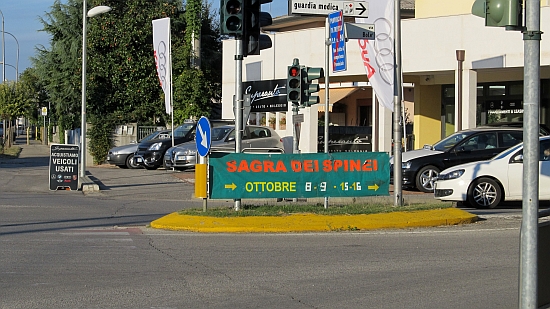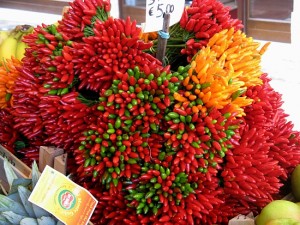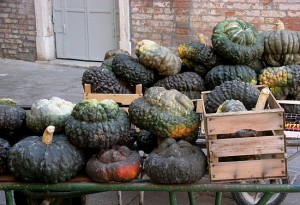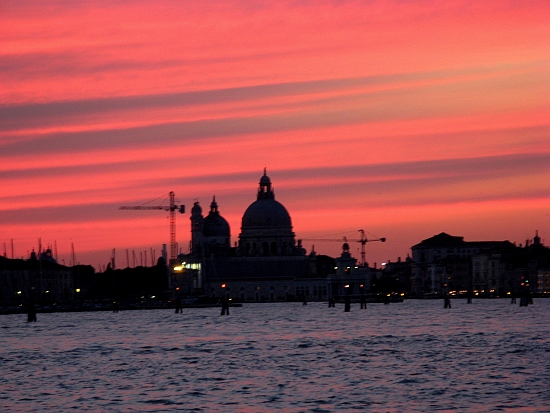They go on all year, all over Italy, but for some reason it’s only in the autumn that I give any thought to the innumerable festivals dedicated to food. Or food products, or plants or animals, or anything peptic or nutritious.

The keyword is sagra, which the dictionary defines as “feast,” “festival,” or “religious festival,” because the local product being celebrated is sometimes linked to the local patron saint. Not required, though. It’s more the local product that is worshiped and glorified. Anyway, the public tends to respond more quickly to the phrases “gastronomic stands” and “typical products” than to “religious procession and Mass,” and these events are usually aimed at the paying visitor, not the quaint locals who in days of yore would have been the only participants.
Rummaging through assorted calendars for something fun and comestible to celebrate this month in the Veneto , I discovered that in October there are sagre devoted to chestnuts, pumpkins, cheese, grapes, jujubes (known in Venetian as zizoe), honey, wine, baccala’, black truffles, ducks, walnuts, apples, eels, and the gnocco (plural gnocchi, since you tend not to eat just one). This one is tempting, as “gnocco” is also slang for “dullard,” “poltroon,” “dimwit,” which I think is funny, though I assume the organizers are not referring to the people they want to attract.

I see that “Automotive Dealer Day” sneaked its way onto the list for the area around Verona. Hard to think of what would be good to eat here, though I guess 40W oil might be useful for frying. Maybe this is one event in which food isn’t involved, hard as that may be to imagine. Unless they are cleverly referring to the automotive dealer as the edible item.
The few sagre I’ve been to tend to follow a simple pattern: Pick a local product you wish to festivize; get lots of it; organize it on stands or in halls, possibly with demonstrations of its cultivation, history, industrial management, recipes, or whatever other features seem important; cook lots of it in various ways to sell at inflated prices; add some extra events, such as demonstrations of historic skills (how to make cheese or spin wool or other things the old-fashioned way is popular); perhaps add some race or competitive event; publicize, provide parking (this one is optional), make money.
Oh — and make sure you hold your event in a picturesque little place that is almost (or better, completely) unreachable by public transport. Trains? Buses? Of course they exist, except on Sunday, when often they do not. Then you get off at the nearest station and try to find a taxi or, as happened last year, you walk. We did eight miles. Lino has made it clear that we are not going to repeat this exploit.

The problem is that any sagra reasonably near home base isn’t very appealing. You need distance, even a frustrating distance, to create the necessary allure. Because — let’s be honest — spending the day wandering among pumpkins or grapes doesn’t have a lot more intrinsic appeal than spending the day in the produce department of the supermarket. Spending the day among gnocchi — why travel? As soon as you walk out the door here, you’re surrounded by them. So to speak.
I spent two days trying to organize the logistics to go to Arqua’ Petrarca, which devotes two consecutive Sundays to its local star, the zizoe. In fact, I had my heart set on it. This is always a bad move, because disappointment is usually right behind. I discovered that while a train does go to the nearest town, Monselice, there are two choices for traveling the four miles (six kilometers) to Arqua’ Petrarca. The first was by taxi — there is one taxi in Monselice — and the driver wanted 20 euros ($27) each way. You see that it’s not only in Venice where they flay your wallet alive. Or the bus. I checked, not without some difficulty, with the bus company, and guess what? They don’t run on Sunday.
I myself would seriously considering getting a folding bicycle , which would be easy to carry on the train, but Lino didn’t want to hear about it. He may have sensed I was edging too close to committing an Americanata.
I forgot to mention that for us to arrive at a sagra at a reasonable hour (say, 9:00 AM, when it might be opening), it means getting up at 4:00. Because to be at the train station by 6:00 or so means there is only one vaporetto running — sorry, I meant crawling. So if I’m prepared to get up in the middle of the night like some shift worker in a Christmas-ornament factory, the sagroids — or however the organizers are called — ought to make some provision for me.
Sending a limousine would be acceptable.

